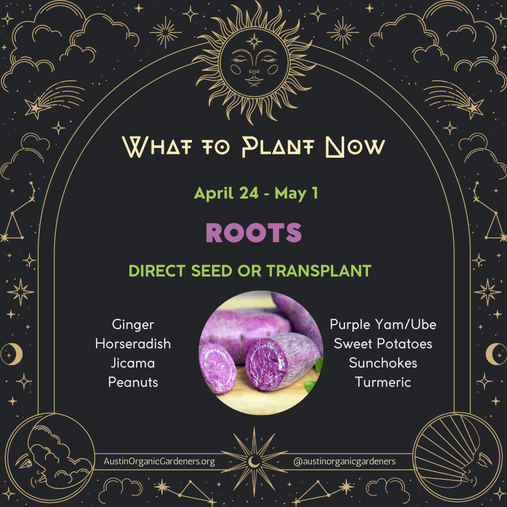 As we are approaching the First Quarter and are in Waxing Crescent, it’s a good time to plant leafy greens especially with the upcoming rains. We recommend you start some seeds indoors if you have a plant light set-up. If you already have seeds planted, they can handle a freeze, but hold off on transplants until the freezing temps have passed. Here is a list of leafy green plants that are recommended for transplanting or direct seeding. During the waxing of the moon (the period extending from the day the moon is new to the day it reaches its fullest point), the moon pulls moisture upwards. Seeds do well during this time because moisture is available at the surface of the soil. It’s always best to try to transplant and seed-in with the coming moisture, but hold off until after the last frost.. SEED INDOORS / TRANSPLANT
SEED OUTDOORS / TRANSPLANT
For more ideas on Ornamentals, Perennials, and Herbs, visit the Central Texas Gardener and The Natural Gardener lists online. Download the Texas A&M Extension Planting Chart and Varieties.  We just passed the Cold Moon or Long Night Moon. This is the first full Moon after the winter solstice, and it falls right during Christmas this year! This Moon occurs when winter cold fastens its grip. We are now going into a waning period of the Moon—from the day after it is full to the day before it is new again. As the moonlight decreases night by night, plants are encouraged to grow roots, tubers, and bulbs. It’s always best to try to plant with the coming rains which are in the forecast. DIRECT SEED OUTDOORS SEED INDOORS/TRANSPLANT
MORE IDEAS For more ideas on Ornamentals, Perennials, and Herbs, visit the Central Texas Gardener and The Natural Gardener lists online. Download the Texas A&M Extension Planting Chart and Varieties.  We just passed the New Moon phase and are now approaching the First Quarter and are in Waxing Crescent. During the waxing of the moon (the period extending from the day the moon is new to the day it reaches its fullest point), the moon pulls moisture upwards. Seeds do well during this time because moisture is available at the surface of the soil. TRANSPLANT
DIRECT SEED OUTDOORS
MORE IDEAS For more ideas on Ornamentals, Perennials, and Herbs, visit the Central Texas Gardener and The Natural Gardener lists online. Download the Texas A&M Extension Planting Chart and Varieties. 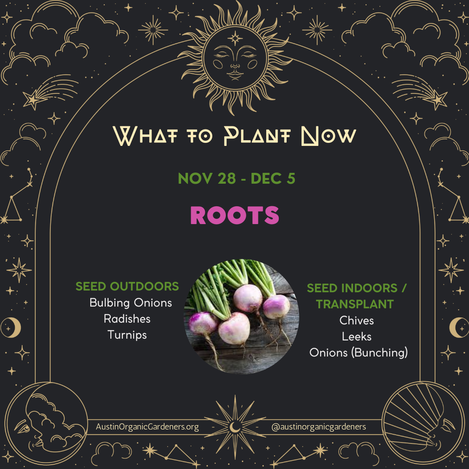 We just passed the Beaver Moon. According to The Old Farmer’s Almanac, Beavers can be seen along the banks of rivers and streams, collecting wood to shore up their lodges and dams before the ice sets in. This was also the time Native American tribes and later European settlers set beaver traps to ensure a supply of warm furs for winter. Because November also signals the time when bitter hard frost’s become more frequent, this month’s moon is also sometimes called the Frost Moon. We are coming up on the winter solstice and we just passed the Cold Moon, a name used by the Mohawk people. This Moon occurs when winter cold fastens its grip. We are now going into a waning period of the Moon—from the day after it is full to the day before it is new again. As the moonlight decreases night by night, plants are encouraged to grow roots, tubers, and bulbs. It’s always best to try to plant with the coming rains which are in the forecast. DIRECT SEED OUTDOORS SEED INDOORS/TRANSPLANT
For more ideas on Ornamentals, Perennials, and Herbs, visit the Central Texas Gardener and The Natural Gardener lists online. Download the Texas A&M Extension Planting Chart and Varieties.  We just passed the Hunters Moon. It is believed that this name originates from the fact that it was a signal for hunters to prepare for the upcoming cold winter by going hunting. This is because animals were beginning to fatten up in preparation for the winter season. We are now going into a waning period of the Moon—from the day after it is full to the day before it is new again. As the moonlight decreases night by night, plants are encouraged to grow roots, tubers, and bulbs. It’s always best to try to plant with the coming rains which are in the forecast. SEED DIRECT SEED INDOORS / TRANSPLANT
MORE IDEAS For more ideas on Ornamentals, Perennials, and Herbs, visit the Central Texas Gardener and The Natural Gardener lists online. Download the Texas A&M Extension Planting Chart and Varieties. 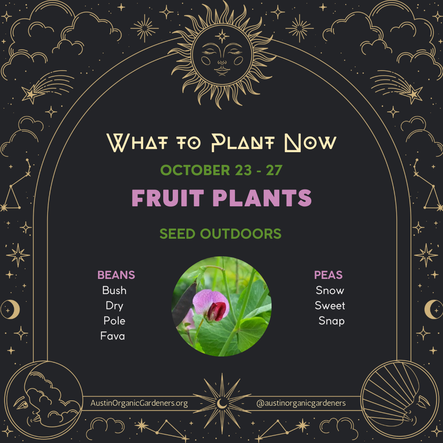 We just passed the first quarter and the moon is now waxing gibbous going into a full moon. Now is also a time to seed-in plants that fruit and seed and can handle a cold snap if we have one. If you already planted these things, remember that it’s a good idea to succession plant and grow twice as much as you will need in case of disease and pest. As always, it’s best to transplant and seed-in with coming rains. DIRECT SEED Beans: Bush, Dry, Pole, Fava Peas: Snow, Sweet, and Snap According to the Old Farmer's Almanac, you should soak pea seeds before planting, as it will help germination. A good rule of thumb is to soak the seeds in water overnight prior to planting. This will make them grow faster. For more ideas on Ornamentals, Perennials, and Herbs, visit the Central Texas Gardener and The Natural Gardener lists online. Download the Texas A&M Extension Planting Chart and Varieties. BECOME A MEMBER Become a member of the oldest organic gardening club in the U.S. at www.AustinOrganicGardeners.org. Memberships are only $25 a year and 100% of your dues support Zilker Botanical Garden. 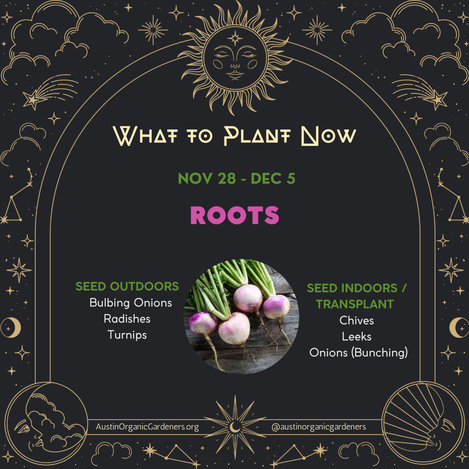 We hope you all enjoyed the shadow work of the annular solar eclipse. We just passed the New Moon phase and are now approaching the First Quarter and are in Waxing Crescent. During the waxing of the moon (the period extending from the day the moon is new to the day it reaches its fullest point), the moon pulls moisture upwards. Seeds do well during this time because moisture is available at the surface of the soil. TRANSPLANT
DIRECT SEED OUTDOORS
For more ideas on Ornamentals, Perennials, and Herbs, visit the Central Texas Gardener and The Natural Gardener lists online. Download the Texas A&M Extension Planting Chart and Varieties. BECOME A MEMBER Become a member of the oldest organic gardening club in the U.S. at www.AustinOrganicGardeners.org. Memberships are only $25 a year and 100% of your dues support Zilker Botanical Garden. #austinorganicgardeners #zone8b #organicgardening #lunarplanting #mooncalendar #moongardening #plantingcalendar #waxingcresent #gardeningbythemoon #biodynamicgardening 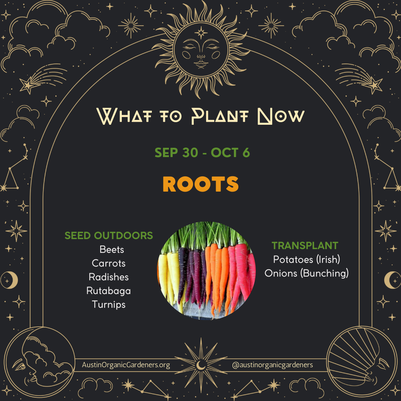 We just passed the Harvest Moon and autumnal equinox for the Northern Hemisphere comes on September 22. We hope that you have all your summer crops harvested and have been preparing your soil for fall crops because there is a lot of root veggies you can direct seeds. We are now going into a waning period of the Moon—from the day after it is full to the day before it is new again. As the moonlight decreases night by night, plants are encouraged to grow roots, tubers, and bulbs. It’s always best to try to plant with the coming rains which are in the forecast. DIRECT SEED Beets Carrots Radishes Rutabaga Turnips TRANSPLANT Potatoes (Irish) Bunching Onions WHERE TO BUY The Natural Gardener and Cultivate Holistic Supply will have bunching online transplants in September. MORE IDEAS For more ideas on Ornamentals, Perennials, and Herbs, visit the Central Texas Gardener and The Natural Gardener lists online. Download the Texas A&M Extension Planting Chart and Varieties. BECOME A MEMBER Become a member of the oldest organic gardening club in the U.S. at www.AustinOrganicGardeners.org. Memberships are only $25 a year and 100% of your dues support Zilker Botanical Garden. 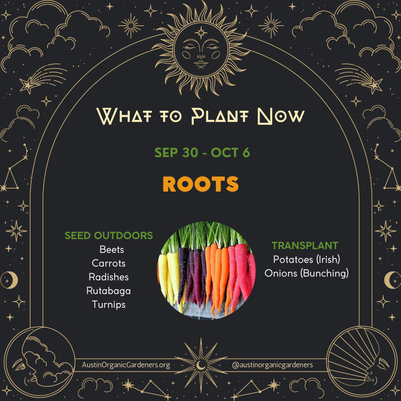 Happy Fall Equinox! We made it and we just passed the first quarter and the moon is now waxing gibbous going into a full moon. Now is also a time to seed-in plants that fruit and seed. If you already planted these things, remember that it’s a good idea to succession plant and grow twice as much as you will need in case of disease and pest. As always, it’s best to transplant and seed-in with coming rains. DIRECT SEED Beans: Bush, Dry, Pole, Fava Peas: Snow, Sweet, and Snap According to the Old Farmer's Almanac, you should soak pea seeds before planting, as it will help germination. A good rule of thumb is to soak the seeds in water overnight prior to planting. This will make them grow faster. MORE FALL GARDEN TASKS 🌾 Plant cover crops in areas you want to replenish for spring. See our comprehensive guide on our website. 🌳Plant all trees, shrubs, and perennials. 🐟 Use fish emulsion to get green growth and do weekly foliar sprays with liquid seaweed to provide plants with hormones and nutrients needed for stress and to prevent disease and pests. 🌼Sow spring wildflower seeds including poppies. Collect deadhead flowering plants. 🍂It’s also a good time to start composting because leaves are starting to fall. 🌷Fall is a good time to transplant, trade, or give away your divisions of daylilies, bearded irises, violets, wood ferns, cannas, and other herbaceous perennials. For more ideas on Ornamentals, Perennials, and Herbs, visit the Central Texas Gardener and The Natural Gardener lists online. Download the Texas A&M Extension Planting Chart and Varieties.
|
AuthorWrite something about yourself. No need to be fancy, just an overview. Archives
May 2024
Categories |
 RSS Feed
RSS Feed